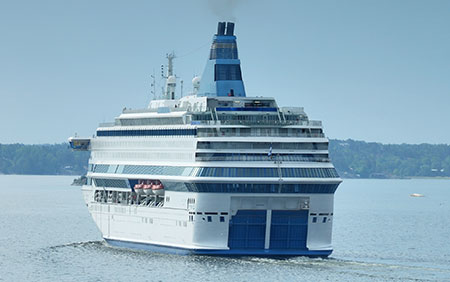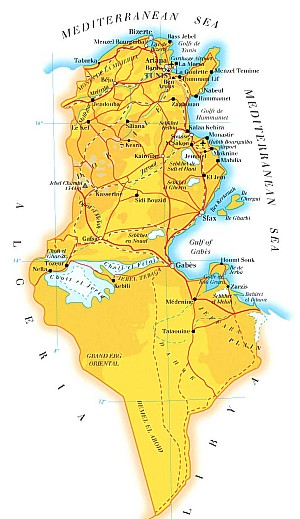|
|
Tunisia Ferries
Ticket Prices & Reservations
Book Tunisia Ferry tickets to and from the Tunisia ferry ports of Tunis and Sfax to Civitavecchia, Genoa, Marseille, Palermo, Salerno, Toulon or Trapani online in advance to enjoy the cheapest available ferry ticket price.
The price you see is the price you pay. There are no hidden extras or surprises such as added fuel surcharges or booking fees and we do not charge you anything extra for paying with a Visa Electron card. The price we quote you for your selected Tunisia Ferry route, onboard accommodation and vehicle type is all you will pay, and that's a promise.
To obtain a Tunisia Ferry ticket price and book your ferry ticket securely online please use the real time ferry booking form on the left. |
More About Tunisia
Tunisia is a safe and friendly country in North Africa. Millions of Europeans visit annually to enjoy the beaches along the Mediterranean and soak up some ancient culture amongst the well-preserved Roman ruins.
Tunisia may be but a slim wedge of North Africa’s vast horizontal expanse, but Tunisia has enough history and diverse natural beauty to pack a country many times its size.
With a balmy, sand-fringed Mediterranean coast, scented with jasmine and sea breezes, and where the fish on your plate is always fresh, Tunisia is prime territory for a straightforward sun-sand-and-sea holiday. But beyond the beaches, it’s a thrilling, underrated destination where distinct cultures and incredible extremes of landscape can be explored in just a few days.
Tunis is refashioning itself as an ambitiously modern Arab capital, though both its long Ottoman and not-so-distant colonial past still have a powerful, palpable presence.
|
 |
In the north, lakes teem with pink flamingos, surprising deep-green forests rise up from the coast, and gently rolling plains are dotted with olive and citrus trees. To the south, the ever-enchanting sands of the Sahara stretch deep into Africa and the traditions of the indigenous Berbers persevere.
Tourism plays a huge part in the economy but Tunisians are surprised, and charmed, by independent travellers. Although around 7 million tourists arrive each year, unless you’re holed up in an all-inclusive hotel in Hammamet, Sousse or Jerba in July, you’re probably going to wonder where the 6,999,995 or so others are.
While there’s precious little that caters specifically for those staying outside resorts, that doesn’t mean that travel isn’t easy here. You’ll discover atmospheric hotels that are pure colonial swansongs, cafes and restaurants where you can gorge on Maghrebi favourites, plates of homemade pasta or perfect pastries for a fraction of the price of those in Italy or France, and often have the unbeatable historical thrill of kicking around a stunning ancient site with just you and the ghosts.
The country’s public transport is cheap and reliable. Plus there are new breeds of hoteliers, restaurateurs and shopkeepers who have taken their cues from the high-end offerings of Morocco and are creating an increasing number of stylish, atmospheric alternatives to the chain monoliths and tourist souqs – but in true Tunisian style they’re both a tad more laid-back and more affordable. North Africa’s most relaxed and hospitable country just might turn out to be its most interesting.
The vast majority of visitors to Tunisia head straight for the resorts at Hammamet, Cap Bon and Monastir, but there is more to the country than sandy beaches and the lovely blue Mediterranean. Here are some highlights:
- Sidi Bou Said: A gorgeous cliff top village overlooking the Mediterranean with steep cobbled streets lined with white-washed houses framed by bright blue window trellises.
- Ksar Ghilaine: A desert oasis on the edge of the vast Saharan dunes, take a camel ride for the day and get lost in the sheer magnificence of this glorious, gold-colored sea of sand.
- Southern Tunisia's Ancient Berber Villages: Southern Tunisia is filled with stark, beautiful landscapes dotted with ancient hilltop Berber villages, multi-storied granaries and troglodyte dwellings. Fascinating to explore, don't miss out on local markets when you go. Star Wars tours in this area are also fun for fans.
- Medinas of Tunis, Sfax and Kairouan: Medinas are old-walled cities, built by the Arabs and Turks and are still in use today. The warren-like alleys are filled to the brim with shops and artisans working much like they have done for hundreds of years.
- Roman Ruins of Carthage, Dougga and El Jem: Tunisia's Roman built monuments are better preserved than many you'll find in Italy. Tours from the resorts will often include El-Jem, the world's best preserved Roman amphitheater.
- Djerba: A lovely island filled with history and a charming main town, Houmt Souk with beautiful architecture and budget hotels in old Caravanserais. Avoid the tourist zone at all costs unless you're just there to get a tan.
Other Tunisia favourites are:
- Sahara - The silent, shifting sands of your dreams. Make it to Ksar Ghilane to see the huge, undulating dunes beyond.
- Sidi Bou Saïd - The bijou beach by the marina is a perfect place to relax; walk down the 365 steps from the village for wonderful views among the eucalypt and pine
- Jerba - An island with the requisite soft sandy beaches as well as the charming, cobblestoned town of Houmt Souq, and a lone fascinating history of ethnic diversity
- Bardo Museum - Home to the world's best collection of Roman mosaics as well as an extensive, beautiful collection of statuary and bronze work
- Lake Ichkeul - Flamingos, herrons, egrets and storks: this is birdwatching bliss. The delicately green and blue marshland is also home to buffalo.
Tunisia has a Mediterranean climate, with hot, dry summers and mild winters. Visiting is best in springtime, between mid-March and mid-May, with warm (but not scorching) temperatures and wild flowers covering the countryside. Summers are great for beach frolics, but this is Tunisia’s high season, so expect prices to go up and crowds of northern Europeans on package holidays to take over the beaches. The desert is much too hot in summer, and the best time to visit Tunisia if you want to see the Saharan dunes is in late autumn. November is when date harvests have just finished and some of the music festivals begin, so this time is perfect for visiting the desert.
|
Tunisia
Tunisia is an eclectic mix of Muslim and secular, East-meets-West, traditional and progressive, offering a taste of the Arabic culture yet just a stone’s throw from home.
With a mild Mediterranean climate, it is a year-round destination for those wanting to enjoy golf, swimming, diving, sailing, sunbathing and other beach activities. Even in January, daytime highs average 16C, rising to 34C in the heights of the long dry summer.
Tunisia has a comparatively low cost of living, allowing visitors to sample sweet pastries or dine out on fresh fish for a fraction of the cost of similar experiences elsewhere. Hotels and apartments offer high standards at competitive prices, making your pound, dollar or euro stretch a long way. Another consideration is that Tunisia is socially and politically stable. It accepts gender equality and welcomes westernised visitors with genuine warmth.
Tunisia’s cultural heritage can be appreciated in the handicrafts on offer in the local souks. Visitors can barter over hand-engraved copper and brassware, woven rugs, hand-knotted carpets, decorative baskets, silk weaving and carved trinkets. Blue and white pottery and hand-painted tiles make wonderful souvenirs.
The Cathaginian, Byzantine, Phoenician, Roman and Ottoman Empires have all left their mark on the culture and archaeology of this fascinating country. Visit the Roman Temple in Dougga, the Phoenician port of Utica, see the remains of Roman villas at Bulla Regia, the Triumphal Arch at Haidra and be amazed at the size of El Jem’s Coliseum. The Bardo Museum near Tunis boasts the largest collection of Roman mosaics in the world.
From the coast, visitors can take trips into the Sahara in 4×4 vehicles to see spectacular desert scenery and learn how the Berbers survive in this inhospitable terrain. Visit a local village, ride a camel, taste fresh dates and see local shepards living a life little changed over many centuries.
Scheduled ferry services to Tunis and Sfax from Civitavecchia, Genoa, Marseille, Palermo, Salerno, Toulon and Trapani ensure easy and regular access to Tunisia from mainland Europe for passengers, cars and freight.
|
Click Here for Tunisia ferry tickets
 |

|
Best Tunisia Ferry Ticket Price Guarantee
Best Price Guarantee - We always offer you our lowest available Tunisia Ferry ticket price and there are no hidden extras or surprises such as added fuel surcharges or booking fees and we also we do not charge you anything extra for paying with a Visa Electron card. The price we quote for your selected Tunisia Ferry to or from Tunis and Civitavecchia, Genoa, Marseille, Palermo, Salerno, Toulon or Trapani , onboard accommodation and vehicle type is all you will pay, and that's a promise!
In the unlikely event you find the same all inclusive Tunisia Ferry ticket cheaper in the brochure of any other tour operator we promise that we will do our best to beat that price or offer you the choice of requesting a refund. To book Tunisia Ferry tickets please click here. |

|
Customer Care, Telesales & Contact Us
At ferryto.net you are able to obtain live Tunisia Ferry ticket prices, check availability and book Tunisia Ferry car and passenger ferry tickets to and from Tunis and Civitavecchia, Genoa, Marseille, Palermo, Salerno, Toulon or Trapani at our lowest available ticket price.
Ferryto.net is part of the world's largest online ferry ticket distribution network providing the ability to book over 80 major European ferry operators including with Tunisia Ferry to over 1,200 ferry routes throughout the UK, France, Spain, Ireland, Holland, Eastern Europe, the Mediterranean, the Baltic and North Africa.
For more information, answers to frequently asked questions or to contact us directly please click here. |
|
|

 Custom Search
Custom Search
